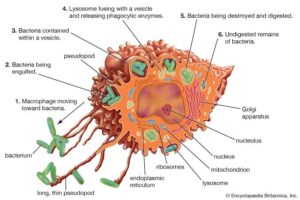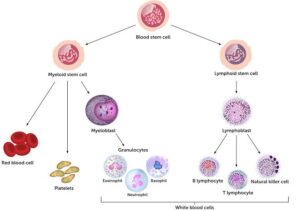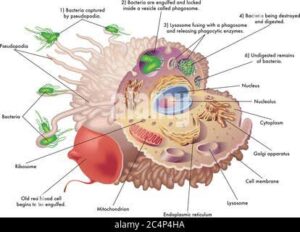Back to: MICROBIOLOGY 100 LEVEL
Welcome to class!
It’s always exciting to have you here, growing stronger in your understanding of how the body works. Today, we’re going into the world of immune cells—the hardworking heroes inside your body that defend you every single day. Two of the most important immune cells are macrophages and lymphocytes. They are like the soldiers and intelligence officers in the body’s defence army, each with special roles to keep you safe from infections.
Immune Cells: Macrophages And Lymphocytes
The immune system is made up of many different types of cells, but macrophages and lymphocytes are two of the key players.

Let’s get to know them better by understanding what they do and how they work together.
Macrophages
The name “macrophage” means “big eater”, and that’s exactly what they are!
Macrophages are large white blood cells that belong to the innate immune system.
Their main job is phagocytosis, which means they swallow and digest harmful invaders like bacteria, dead cells, and other debris.
After swallowing a pathogen, a macrophage breaks it down using special enzymes.
Macrophages also send signals to other immune cells, helping to start a more specific immune response.
Where can you find them?
Macrophages are found in almost every tissue of the body—especially in places like the lungs, liver, and lymph nodes. They act as patrol officers, always on the lookout for trouble.

Example: If bacteria enter your wound, macrophages rush to the area and begin swallowing the bacteria while alerting other immune cells to join the fight.
Lymphocytes
Lymphocytes are small but very smart. They are part of the adaptive immune system, which is slower to respond but very specific and long-lasting.
There are two major types of lymphocytes:
B lymphocytes (B cells):
They produce antibodies, which are proteins that recognise and attach to antigens (foreign substances).
Antibodies help to neutralise or mark invaders for destruction.
B cells can also form memory cells that remember infections.
T lymphocytes (T cells):
Helper T cells (CD4+): They help activate B cells and other immune cells.
Killer T cells (CD8+): They destroy cells infected with viruses or cancerous changes.
T cells also form memory cells for long-term protection.
Where are lymphocytes found?
They circulate in the blood and are stored in the lymph nodes, spleen, and bone marrow—ready to spring into action when needed.

How Do They Work Together?
Macrophages and lymphocytes often team up. After a macrophage eats a microbe, it presents pieces of the invader (antigens) to lymphocytes. This “presentation” helps B and T cells recognise the invader and launch a stronger and more targeted attack.
Summary
- Macrophages are part of the innate immune system. They perform phagocytosis (engulfing and digesting invaders).
- Lymphocytes are part of the adaptive immune system and include B cells (produce antibodies) and T cells (kill infected cells and help other immune cells).
- Macrophages act quickly and help to activate lymphocytes by presenting antigens.
- Lymphocytes provide specific and long-lasting protection, including memory for faster future responses.
- Both types of cells work together to keep the body healthy and protected from disease.
Evaluation
- What is the main role of macrophages in the immune system?
- Name two types of lymphocytes and one function of each.
- How do macrophages and lymphocytes work together during an infection?
Every lesson adds another layer to your growing knowledge—and today, you’ve learned how some of the body’s most powerful defenders work. Keep your head high and your mind open—Afrilearn is always here to support your journey to greatness. See you in the next lesson!
